Advertisements
Advertisements
Question
In the figure, given below, AD = BC, ∠BAC = 30° and ∠CBD = 70°.
Find:
- ∠BCD
- ∠BCA
- ∠ABC
- ∠ADB
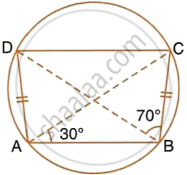
Solution
In the figure, ABCD is a cyclic quadrilateral
AC and BD are its diagonals
∠BAC = 30° and ∠CBD = 70°
Now we have to find the measure of
∠BCD, ∠BCA, ∠ABC and ∠ADB
We have ∠CAD = ∠CBD = 70° ...[Angles in the same segment]
Similarly, ∠BAD = ∠BDC = 30°
∴ ∠BAD = ∠BAC + ∠CAD
= 30° + 70°
= 100°
i. Now ∠BCD + ∠BAD = 180° ...[Opposite angles of cyclic quadrilateral]
`=>` ∠BCD + ∠BAD = 180°
`=>` ∠BCD + 100° = 180°
`=>` ∠BCD = 180° – 100°
`=>` ∠BCD = 80°
ii. Since AD = BC,
ABCD is an isosceles trapezium and AB || DC
∠BAC = ∠DCA ...[Alternate angles]
`=>` ∠DCA = 30°
∴ ∠ABD = ∠DAC = 30° ...[Angles in the same segment]
∴ ∠BCA = ∠BCD – ∠DAC
= 80° – 30°
= 50°
iii. ∠ABC = ∠ABD + ∠CBD
= 30° + 70°
= 100°
iv. ∠ADB = ∠BCA = 50° ...[Angles in the same segment]
APPEARS IN
RELATED QUESTIONS
AB is a diameter of the circle APBR as shown in the figure. APQ and RBQ are straight lines. Find : ∠PRB
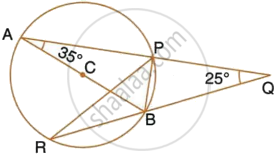
The given figure shows a circle with centre O and ∠ABP = 42°.

Calculate the measure of:
- ∠PQB
- ∠QPB + ∠PBQ
In a cyclic-trapezium, the non-parallel sides are equal and the diagonals are also equal. Prove it.
In the given figure, ∠ACE = 43° and ∠CAF = 62°; find the values of a, b and c.

AB is a diameter of the circle APBR as shown in the figure. APQ and RBQ are straight lines. Find : ∠PBR
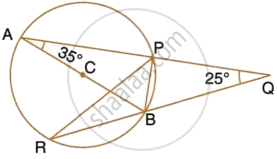
If I is the incentre of triangle ABC and AI when produced meets the cicrumcircle of triangle ABC in points D . if ∠BAC = 66° and ∠ABC = 80°. Calculate : ∠IBC
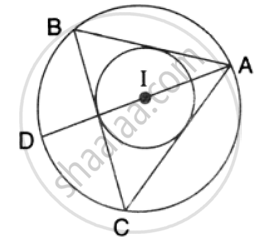
In the given Figure. P is any point on the chord BC of a circle such that AB = AP. Prove that CP = CQ.
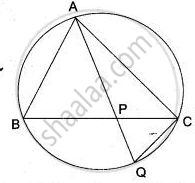
In the given below the figure, AB is parallel to DC, ∠BCD = 80° and ∠BAC = 25°, Find
(i) ∠CAD, (ii) ∠CBD, (iii) ∠ADC.

In the following figure, O is the centre of the circle, ∠ PBA = 42°.
Calculate:
(i) ∠ APB
(ii) ∠PQB
(iii) ∠ AQB
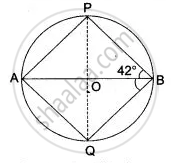
In the given figure (drawn not to scale) chords AD and BC intersect at P, where AB = 9 cm, PB = 3 cm and PD = 2 cm.
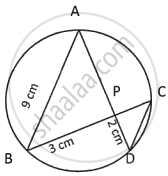
- Prove that ΔAPB ~ ΔCPD.
- Find the length of CD.
- Find area ΔAPB : area ΔCPD.
